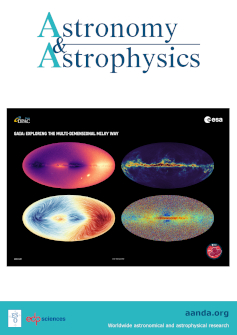皮克托里星周围的外行星轨道分布
IF 5.4
2区 物理与天体物理
Q1 ASTRONOMY & ASTROPHYSICS
引用次数: 0
摘要
约 23 Myr 的年轻恒星 β Pictoris(β Pic)是行星形成研究的实验室,因为它有观测到的碎片盘、直接成像的超类木行星 β Pic b 和 c,以及定期在该恒星前方凌日的太阳系外彗星的证据。β Pic 星周围外行星凌日的最新证据来自 TESS 空间任务获得的恒星测光时间序列。之前对这些凌星的分析将基本外行星群的轨道分布限制在约 0.03 至 1.3 AU 之间,并假设了一个固定的凌星撞击参数。我们研究了观测到的凌日持续时间(Δt)的分布情况,以推断底层外行星样本的轨道表面密度分布(δ)。我们适当考虑了圆形轨道几何过境概率的影响,但假定过境彗星及其可能的蒸发物质云的半径远小于恒星半径。我们的研究表明,在β Pic周围的一条狭窄的外彗星带中,如果凌日撞击参数是随机的,但轨道半长轴是相等的,那么就会出现凌日持续时间过长的现象。这与观测结果形成了鲜明对比,观测结果显示出短凌日(Δt ≈ 0.1 d)的堆积,只有少数凌日的尾部Δt > 0.4 d。在大约 0.03 至 2.5 AU 之间的外彗星的扁平密度分布使得得出的Δt 分布与观测结果更加匹配,但是预测的Δt 直方图的斜率不够陡峭。δ∝aβ幂律与观测结果的吻合度更高。我们的模型显示,β = -0.15-0.10+0.05时,观测到的Δt分布与预测的Δt分布最为吻合。一个更合理的方案是将外轨迹建模为双曲线轨道,这也能在一定程度上再现观测到的Δt分布。未来的研究可能会通过全面探索高偏心轨道的四维参数空间来重现观测到的Δt分布,而且可能需要放宽我们的假设,即凌日物体小于恒星盘。目前在 β Pic 星周围观测到的外行星凌日数量太少,无法验证之前报道的两个不同的外行星家族的区别,但未来对该恒星的 TESS 观测可能会验证这一点。尽管如此,我们的研究结果表明,彗星物质存在于高度偏心的轨道上,其半长轴的范围比以前的光谱观测所显示的范围更广。本文章由计算机程序翻译,如有差异,请以英文原文为准。
Exocomet orbital distribution around β Pictoris
The ~23 Myr young star β Pictoris (β Pic) is a laboratory for planet formation studies because of its observed debris disk, its directly imaged super-Jovian planets β Pic b and c, and the evidence of extrasolar comets that regularly transit in front of the star. The most recent evidence of exocometary transits around β Pic came from stellar photometric time series obtained with the TESS space mission. Previous analyses of these transits constrained the orbital distribution of the underlying exocomet population to a range between about 0.03 and 1.3 AU assuming a fixed transit impact parameter. We examine the distribution of the observed transit durations (Δt) to infer the orbital surface density distribution (δ) of the underlying exocomet sample. The effect of the geometric transit probability for circular orbits was properly taken into account, but we assumed that the radius of the transiting comets and their possible clouds of evaporating material are much smaller than the stellar radius. We show that a narrow belt of exocomets around β Pic, in which the transit impact parameters are randomized but the orbital semimajor axes are equal, results in a pile-up of long transit durations. This is in contrast to observations, which reveal a pile-up of short transit durations (Δt ≈ 0.1 d) and a tail of only a few transits with Δt > 0.4 d. A flat density distribution of exocomets between about 0.03 and 2.5 AU results in a better match between the resulting Δt distribution and the observations, but the slope of the predicted Δt histogram is not sufficiently steep. An even better match to the observations can be produced with a δ ∝ aβ power law. Our modeling reveals a best fit between the observed and predicted Δt distribution for β = −0.15−0.10+0.05. A more reasonable scenario in which the exocometary trajectories are modeled as hyperbolic orbits can also reproduce the observed Δt distribution to some extent. Future studies might reproduce the observed Δt distribution with a full exploration of the four-dimensional parameter space of highly eccentric orbits, and they might need to relax our assumption that the transiting objects are smaller than the stellar disk. The number of observed exocometary transits around β Pic is currently too small to validate the previously reported distinction of two distinct exocomet families, but this might be possible with future TESS observations of this star. Our results nevertheless imply that cometary material exists on highly eccentric orbits with a more extended range of semimajor axes than suggested by previous spectroscopic observations.
求助全文
通过发布文献求助,成功后即可免费获取论文全文。
去求助
来源期刊

Astronomy & Astrophysics
地学天文-天文与天体物理
CiteScore
10.20
自引率
27.70%
发文量
2105
审稿时长
1-2 weeks
期刊介绍:
Astronomy & Astrophysics is an international Journal that publishes papers on all aspects of astronomy and astrophysics (theoretical, observational, and instrumental) independently of the techniques used to obtain the results.
 求助内容:
求助内容: 应助结果提醒方式:
应助结果提醒方式:


